Accessibility Guide to Yellowstone National Park
Yellowstone Accessibility
“All parks have certain challenges,” says Lori Gruber, Yellowstone accessibility coordinator, about access for visitors with mobility issues. “In Yellowstone the weather and number of pedestrians can cause problems in something seemingly as simple as where a boardwalk meets a trail or asphalt.” Still, media entities including Frommers, Roadtrippers.com, Men’s Journal, Outdoorsy.com, AmeriDisability, and Outside have recognized Yellowstone as one of best national parks for those with mobility issues.
The park’s Accessibility Guide to Yellowstone booklet, which is also available on the park website, includes the most detailed accessibility maps and information organized by developed area. Download the free NPS Yellowstone app, which has a park map over which you can apply a “Wheelchair Access” filter to show trailheads and facilities that are wheelchair accessible. Also, the park’s primary front-country boardwalks and trails — Canyon, Fountain Paint Pot, Fort Yellowstone, Mammoth Hot Springs, Mud Volcano, Norris Geyser Basin, Old Faithful, West Thumb, and Old Faithful Historic District — have trail guides that include a map. These maps note where the site meets federal standards for wheelchair accessibility.
Almost all activities and tours offered by Yellowstone National Park Lodges can accommodate visitors in wheelchairs.
The America the Beautiful – The National Parks and Federal Recreational Lands Pass Series includes the Access Pass, a free, lifetime admission and discount pass for U.S. citizens and permanent residents with permanent disabilities. The pass is available online and at Yellowstone’s entrances and visitor centers with a $10 processing fee. There is no processing fee when purchased in person at a park entrance.
Yellowstone National Park allows qualified service animals that assist people with disabilities and defines a service animal as “a dog that performs some of the functions and tasks that the individual with a disability cannot perform such as carrying a pack for persons with mobility impairments, assisting persons with balance, or alerting medically dependent persons of specific conditions such as oncoming seizures.” Dogs meeting this definition must be leashed. Companion dogs and other pets that are used to provide comfort or emotional support are not allowed in buildings, the backcountry, on nature trails, or on boardwalks.
Here are the accessibility details for the developed areas of the park.
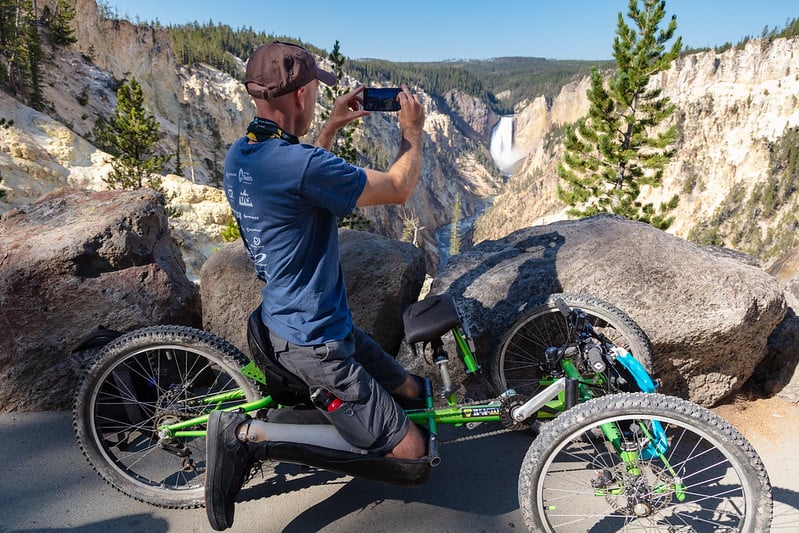 Canyon
Canyon
Gruber says Canyon is the most accessible area of the park for visitors in wheelchairs. “The Canyon Village Area includes views and waterfalls, and an accessible visitor center, lodging, campground, restaurants, and shopping,” she says. “The Overlooks and Trails Restoration Project has been a multi-year effort to restore the many viewpoints from which people enjoy the Grand Canyon of the Yellowstone, the Upper Falls, and the Lower Falls. Artist Point, Inspiration Point, Lookout Point, and Grand View have been restored with accessible parking, vault toilets, and routes to overlooks.”
The Canyon Visitor Education Center is wheelchair accessible, and all the Lodges and five Western Cabins have accessible rooms.
Visit the park’s Accessibility in the Canyon Area for more information.
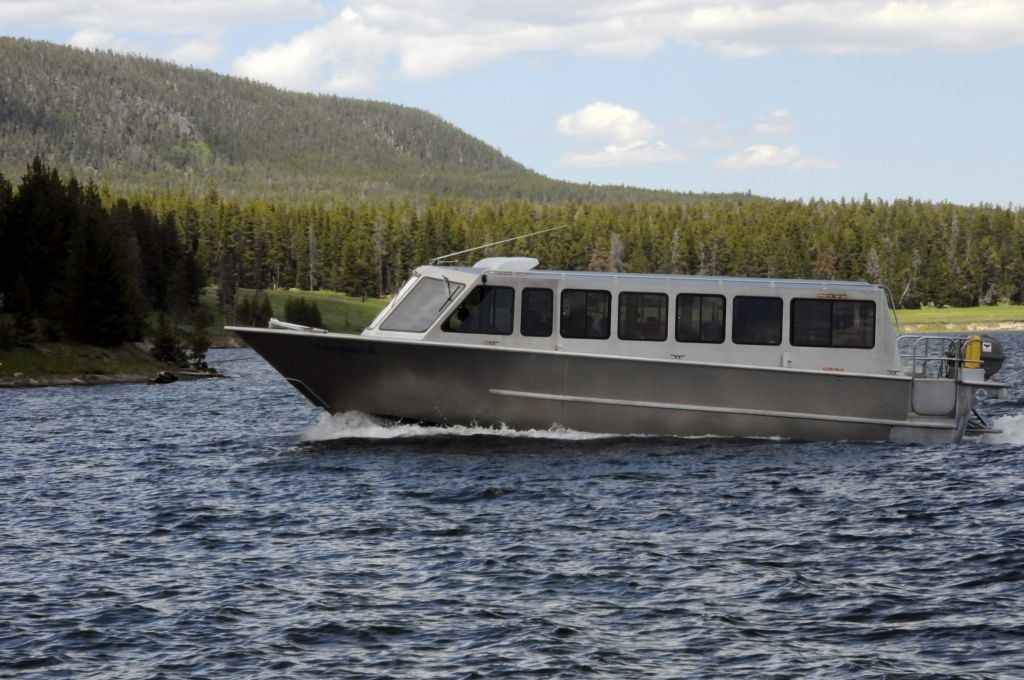
Lake
For years, Gruber has recommended that visitors with mobility challenges take the one-hour Scenicruise on Yellowstone Lake, which leaves from Bridge Bay Marina. “The boat has a place to secure a person in a wheelchair, has great interpretive guides, and is a bargain for the price,” she says. After departing Bridge Bay, the Lake Queen heads out and around Stevenson Island, most notable for the wreck of the 500-passenger ship, the E.C. Waters, which has sat off its shore since 1906. In addition to the shipwreck, you might also see eagles and osprey while on this cruise.
After the Old Faithful Inn, the most iconic property at the park is the Lake Yellowstone Hotel. On the shore of Yellowstone Lake, this hotel was built in 1891, but in 1903 went through a significant redesign — turning it into the Colonial Revival-style building we know today — at the hands of architect Robert Reamer, who also designed the Old Faithful Inn. There are 13 accessible rooms inside the hotel and several accessible cabins nearby.
Visit the park’s Accessibility in the Lake Area for more information.
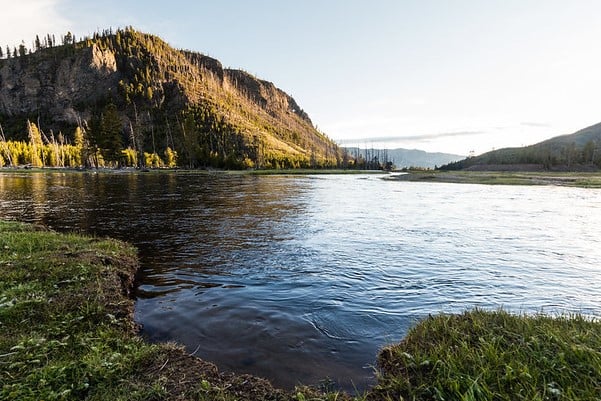
Madison
There is a wheelchair-accessible fishing area on the Madison River. Park at the Mount Haynes Overlook. From here, a level boardwalk leads to the river and fishing access. (Whether in a wheelchair or not, anyone over the age of 16 requires a Yellowstone National Park fishing permit to fish in the park; state fishing licenses are not valid here.)
Other accessible sites in this area include viewpoints of National Park Mountain and Firehole Cascade. The Two Ribbons Trail is a wheelchair-accessible boardwalk along the Madison River; the boardwalk loop to Terrace Spring includes a steep grade in the middle that wheelchair users will likely need assistance to get up.
Visit the park’s Accessibility in the Madison Area for more information.
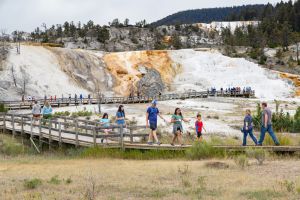
Mammoth
The Mammoth Hot Springs Hotel and Cabins has two accessible hotel rooms and four accessible cabins. If you don’t stay here, at least check out the hotel’s accessible Map Room, which features a 17-foot 2-inch by 10-foot 4-inch map made of 2,544 pieces of wood from 15 different species of trees. The map shows the U.S. as it was in 1936. In non-Covid times, the room offers a bar menu. If you want more to eat, try the accessible Mammoth Hotel Dining Room, which is the first 4-star certified restaurant by the Green Restaurant Association in the entire National Park System. The dining room is accessed through the Mammoth Terrace Grill.
Like at Old Faithful, many of the Mammoth boardwalks are accessible but have some steep sections and transitions from asphalt walkways to boardwalks that will likely require manual wheelchair users to be assisted. See the Mammoth Hot Springs Trail Guide Map, available at trailheads in the area, for details on these sections. There is an accessible parking space on the left a short distance upon entering Upper Terrace Drive; from here, a boardwalk begins on the right and takes you to views of the hot springs. About .7 of a mile farther along Upper Terrace Drive, there’s another wheelchair-accessible parking spot and a short boardwalk to Orange Spring Mound.
The 1909 Albright Visitor Center underwent a recent structural renovation. The building’s historic nature was preserved while wrought-iron handrails were added to the stairs and a new access ramp at the front entrance. The interior building and museum displays are all accessible.
The half-mile Forces of the Northern Range boardwalk loop between Mammoth and Tower Junction is wheelchair accessible. Passing over open meadows, the trail includes interpretive signs, benches, and exhibits that explain the area’s mountains, geology, and landscape.
Visit the park’s Accessibility around the Mammoth Area for more information.
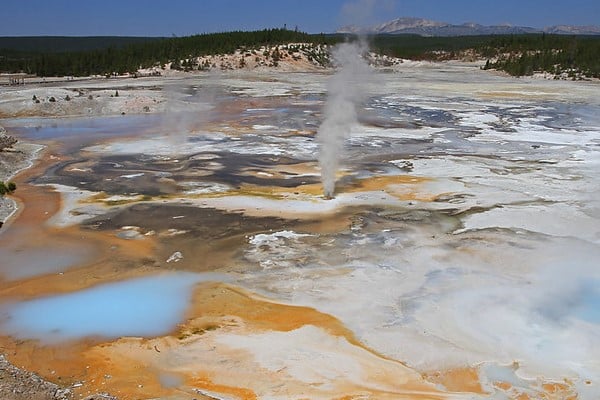 Norris
Norris
Norris is the hottest, most acidic, most changeable, and most varied thermal area in the park. Wheelchair travel into Porcelain and Back Basins is not possible because of stairs, steep sections, and changes in trail surface, among other issues. With assistance, wheelchair users can reach Emerald Pool along with Echinus and Steamboat Geysers, which is well worth the effort. The two geysers are among the most interesting in the park: Echinus is the largest of the known acid-water geysers in the world; Steamboat is the tallest active geyser in the world. Steamboat’s eruptions can be between three days and 50 years apart. From March 2018 to the end of 2020, Steamboat has erupted an unprecedented 128 times. By comparison, between 1985 and 2017, the geyser had only 15 major eruptions. If you’re fortunate enough to catch one, it can shoot water as high as 380 feet into the air.
The Museum of the National Park Ranger, in a 1908 building that was one of the park’s original soldier stations, has a wheelchair-accessible entrance and exhibits on the history of the National Park Service and the ranger profession. The building will be closed for rehabilitation in 2021.
The lower portion of the Artists Paintpots Trail, several miles south of Norris Junction, is wheelchair accessible. (Note that the upper trail is not.)
See the park’s Accessibility in the Norris Area for more information.

Old Faithful
Opened in August 2010, the Old Faithful Visitor Education Center is fully ADA-compliant and includes exhibits on almost everything you ever wanted to know about hydrothermal features.
All of the hotels and restaurants in the Old Faithful area are accessible, including the historic Old Faithful Inn, which has hosted guests since 1904 and has a seven-story lobby, the centerpiece of which is an 85-foot-tall stone fireplace. The upper lobby may be accessed via an elevator
There are wheelchair-accessible boardwalks and walkways to Old Faithful, which is neither the biggest geyser nor the most predictable geyser in the park but is the biggest predictable one. The next biggest attraction in this area is the Grand Prismatic Spring, the country’s largest hot spring and the world’s third-largest. It’s 121 feet deep, bigger than a football field in diameter, and, because of heat-loving microbial mats, a rainbow of colors. The .8-mile boardwalk around it is accessible and has benches.
See the park’s Accessibility in the Old Faithful Area for more information.
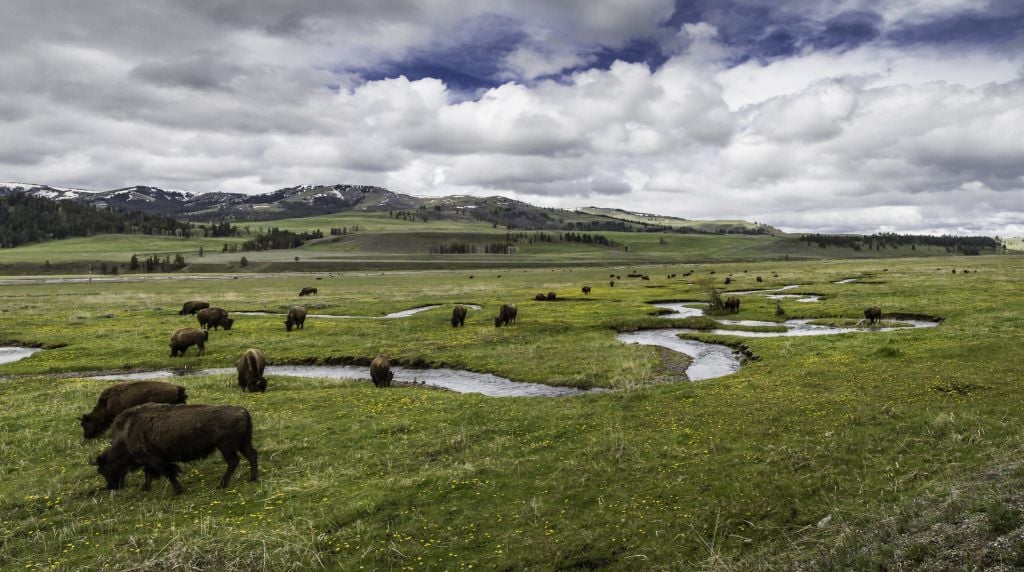
Tower-Roosevelt
The highlight of this area is watching wildlife in the Lamar Valley — seeing bison is pretty much a given, and if you’re lucky, wolves are as well. Numerous viewing areas have wayside exhibits and some have designated accessible parking. The best way to find these is via the NPS Yellowstone app. Go to the map and put on the “Wheelchair Accessible” filter.
Note that the trail to Tower Fall will be accessible upon completion of the road construction project in that area, possibly late fall 2021.
See the park’s Accessibility in the Tower-Roosevelt Area for more information.

West Thumb
The West Thumb Geyser Basin is the largest group of geysers on the shore of Yellowstone Lake, the largest high-elevation lake in North America. The boardwalk loops here are accessible with assistance (the lower loop has a section on which the grade is almost 10 percent). Visitors using wheelchairs can get to the Thumb Paint Pots and Twin Geyser without assistance.
See the park’s Accessibility in the West Thumb Area for more information.
Written by: Dina Mishev
Dina Mishev is a freelance writer based in Jackson Hole, Wyo.
For more travel experiences to Beautiful Places on Earth™ available from Xanterra Travel Collection® and its affiliated properties, visit xanterra.com/explore.
Want to experience Yellowstone in-depth? See what makes Yellowstone National Park a great place to work for a season or longer!
Read More
- Read More